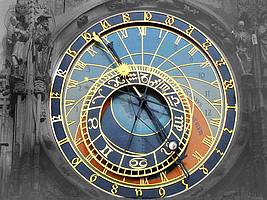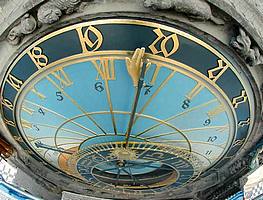
The astronomical dial 
The astronomical dial of the Prague Astronomical Clock is an astrolabe driven by the clock machine. The data for which it is designed can be read on the astrolabe. Pointers of sometimes bizarre and decorative shapes are quite usual. It is also possible to read the positions of the depicted objects on the curves or within the fields. The way how it is done, that is the ingenuity of the creators of astronomical clocks. There was no versatile guide, so each astronomical clock was and still is a unique machine of its kind, designed for the place where it was built. The accuracy of the indicated data corresponded with the time of the making. Medieval clocks could show deviations even half an hour per day. That is why you will not find seconds on these clocks and minutes can be rather estimated. The dial of the Prague astronomical clock is designed in an unusually sophisticated way even when compared to other European clocks. Details of the technical and mechanical arrangement of the movements are shown on detailed photographs in this chapter.
The centre of the astronomical dial
Three movements driven by the machine are transmitted through
one axle – one axle and two coaxial hollow shafts. The different number
of teeth of the main wheels inside the clock ensures different rotation
speed of the Sun, the Moon and the Zodiac in a way corresponding to
their movement in the sky. The centre of the rotation is projected to
the geographic position of the clock, i. e. Prague. This system was
already present in the original clock (1410); it represented the
supreme technology of its time and it is one of the notable things
about the clock. The present system is from later times.
The Zodiac ring
The names of constellations in the sky were created as early as in Antiquity. The apparent trajectory of the Sun over the sphere around the Earth is called the ecliptic and passes mainly through constellations named after animals. The Sun passes through each sign for about a month and passes through all of them in the course of the year. The Moon moves along the same ecliptic trajectory but at a different speed. There are 72 beams on the edge of the ring that serve for finer division of individual months into days. The intervals between adjacent beams represents approximately 5 days. This finer division on the Prague astronomical clock is unique; however, it was created as a correction of an incorrect calculation in 1864. The ring with beams attached to the clock with rivets was an amendment of a too small diameter of the Zodiac. However, the bars to which the Sun and the Moon are attached were not extended, so they move along the original shorter diameter and thus at a lower level, which is not correct.

The centre of the Zodiac ring
In the geometric centre of the Zodiac ring, the bars of the Sun and the Moon are attached in a rotatable way to the common axle; the bars maintain the Sun and the Moon on the ecliptic trajectory all over the year. They can slide along the auxiliary bars and as the ring is eccentric, they can indicate the altitude above the horizon in various seasons of the year according to the actual situation in the sky in a simple mechanical manner. This simple system is also original.
The symbol of the Sun
rises and sets, passes through the field of the astronomical night and
rises again just as in the sky. It is made of gilded sheet metal and
moves along the same arm as the golden hour-hand and makes one turn per
24 hours together with it. At the same time, the Sun shows the Zodiac
Sign it passes through; in the course of the day, the Sun also shows
whether it is day, dusk, night or dawn. By its position between the
lines 1–12, it also indicates the Babylonian time in the blue field of
the dial. Or else, it would indicate it if it was at the level of the
subsequent adjustment of the Zodiac. In the actual arrangement, the
time is indicated by the intersection of the Sun arm and the outer edge
of the Zodiac.
The Moon
It moves along the ecliptic by the same mechanical
principle as the Sun. It is hollow and encased in a half cage with
rotating points. The lug at the rear side of the cage slides along an
auxiliary bar. It indicates moon phases depending on its position
towards the Sun just as in reality. Inside the sphere with the diameter
of 130 mm, there is a hidden
mechanism that rotates the shell of the sphere at each turn
from the inside. Thus it shows the current moon phase. At the time of a
full moon, it shows the entire illuminated hemisphere and it is in
opposition on the Sun on the clock, i.e. on the opposite side. At
night, it shines with reflected light. When eclipsed by the Sun, it is
completely dark so it is “not visible”. We do not know when this
mysterious machine was created. Probably it was during the
reconstruction in the second half of the 17th century.
The Golden hand
It is the most distinct indicator on the astronomical
clock. It reaches over the greatest diameter of the dial, where there
is the pendulous scale of the 24hour ring (see the dedicated chapter);
there the hand indicates the Old Czech Time. Simultaneously, it
indicates the German time on the scale with Roman numerals; here the
day begins and ends at midnight just as today. The scale on the clock
has 24 hours because the pointer – golden hand – is only one and makes
one turn per one solar day. However, it is divided into 2 x 12 hours
(in Roman numerals, from I to XII) where the upper symbol XII indicates
noon and the lower one midnight. This arrangement has one unexpected
advantage: when the long golden hand is partially covered by the
movable parts of the astrolabe (Sun, Moon, Zodiac), which happens in
the summer when the Sun is at the highest position in the sky and,
moreover, can be eclipsed by the Moon if in the phase of new moon, the
time can be read at its extension on the other side of the dial, where
the numbering is identical. The observer easily recognizes whether it
is day or night at the moment of the reading. The heavy augmented end
also acts as a counterweight of the golden hand (the Moon has a similar
arrangement of a counterweight as a pointer). The use of the German
time in Czech lands was ordered under the rule of Emperor Ferdinand I
in 1547.
The sideral time
is related to the apparent movement of distant
stars due to the Earth’s rotation. Compared to the solar day, which is
24 hours long, the sideral day is 4 minutes shorter. The difference is
due to the fact that the Earth shifts during its single turn, compared
to the stars, along its trajectory around the Sun, which is at that
moment at a different position in the sky than it was at the beginning
 of the sideral day. During one
year, the difference increases to one day. That is why the pointer is
located at the Zodiac ring, which indicates the positions of the stars
towards the Sun. The star is attached to an arm extended from the
position of the ring at the vernal equinox.
of the sideral day. During one
year, the difference increases to one day. That is why the pointer is
located at the Zodiac ring, which indicates the positions of the stars
towards the Sun. The star is attached to an arm extended from the
position of the ring at the vernal equinox.
Besides astronomers, the sideral time is used by astrologers for compilation of horoscopes.
 The Old Czech
Time (or else Italian time)
The Old Czech
Time (or else Italian time)
is read
on so-called 24-hour dial. This annulus with stylized Gothic numerals
from 1 to 24 has the greatest diameter on the entire clock; it is 300
cm. It represents another – the fourth – movement around the centre of
the astronomical dial, although it is driven by a complex transmission
hidden behind the plate (see dedicated chapter). Its pendulous movement
by 60° over the entire year is the slowest movement on the astronomical
clock. In the course of the year, the commencement of the day shifts;
the day in the Old Czech Time commenced in the moment of the sunset,
which means, in common life, by the night. It is indicated by the
golden hand at 24, whereas the Sun is on the line of dusk. In the time
of the making of the clock, this time was still used. The animation
shows the movement of the 24-hour dial during the entire year and
indicates the beginning of the day in the position where the Sun enters
the Zodiac Sign.

The fundamental
fixed plate
can only be seen in its entirety during extensive repairs like the one
in 2005. Its diameter is 260 cm and its graphic appearance is partially
covered by the moving pointer elements during the year. The basic
division is differentiated by colours: the blue field represents the
day when the Sun is above the horizon, the orange field represents the
dawn (AVRORA) and dusk (CREPVSCVLVM). The lines ORTVS and OCCASVS are
the lines of the east and west. The inscriptions are made in the
antique style; Romans wrote the letter U as V. In the 19th century,
dignity and respectability of institutions was emphasized in this
manner, e. g. as in the inscription MVSEVM.
The tropics
are not marked verbally. The golden plastics circle on the outwards
perimeter of the plate is the tropic of Cancer (the Sun touches it in
the summer when it is at its highest position), the winter tropic of
Capricorn is at the smallest diameter. Between then, there is another
unlabelled golden circle that represents the equator. 
The black field represents the astronomical night, which begins in the moment when the Sun is more than 18° under the horizon. The black night disc does not touch the edge of the plate, which allows an orange gap for the movement of the Sun in the period of peaking summer. The Sun moves in that period in the vicinity of the tropic of Cancer, the astronomical night does not come and the Sun disc, which is at its highest position, can pass through this gap without entering the black night field. The Roman numbering marks civil hours, or else German hours, as we know them today.
The curves
marking fields 1–12 in the blue day field demarcate the areas for
determination of the Babylonian time. It is also called planetary time;
according to Babylonians, each hour was ruled by a planet. The day is
divided into 12 hours (and so is the night); at dawn, the Sun indicates
the first hour and in the moment of the sunset it indicates the end of
the twelfth hour. The noon as we know it comes at 6 o’clock of the
Babylonian time. The duration of one Babylonian hour changes in the
course of the year; it is longest in the summer and shortest in the
winter. In historical terms, it is the oldest time indicated on the
clock. Reportedly, it is measured nowhere else in the world.







